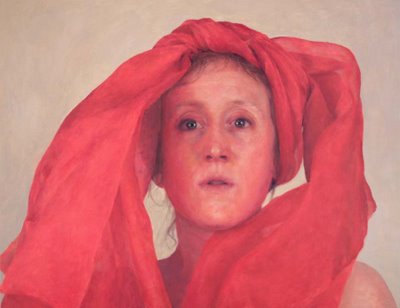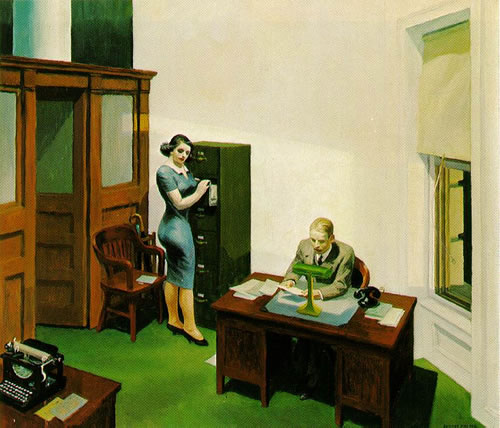Evaluate and Discuss the Technique and Process:
What decisions throughout your process were risky or bold?
The last painting ("Studio with a Red Chair") was kind of a risk for me and the things I usually paint. I'd actually never made a painting of a figure-less setting before, other than for simple painting exercises in high school. It was a challenge to create an atmosphere and emotion with just color, value, and composition; no human figures or facial expressions to tell the viewer how to feel.
The last painting ("Studio with a Red Chair") was kind of a risk for me and the things I usually paint. I'd actually never made a painting of a figure-less setting before, other than for simple painting exercises in high school. It was a challenge to create an atmosphere and emotion with just color, value, and composition; no human figures or facial expressions to tell the viewer how to feel.
Another risky decision I made earlier in the semester was to work entirely with the pallet knife for one of my paintings:
I'd experimented a little with painting with the pallet knife in previous paintings, but it was mostly only to texturize the setting or background. For this painting, I also painted the figure with the pallet knife. This brought a sort of consistency to the painting that I'd never really accomplished before.
Another risk I took was in my attempt and creating an abstract impressionist sort of setting in "Woman on the Ladder", this didn't work out so well. The reason it was not as successful as other risks I'd taken, I realized later, was that I didn't take enough of a risk. I could have worked more on the trees in the background, adding more and more layers to bring it further into abstraction. I also could have tried to paint the figure in a way that it too takes on the character of abstract expressionism. Not bold enough!
I felt this area was successful:
Areas like this definitely needed more work:
What decisions were safe or unchallenging to your usual way of working?
The decision to paint from photographic references was a pretty safe one, it's much easier to paint all of the proportions and perspective correctly. Also to paint compositions where the main focus is a figure -- it is easier to portray a human feeling in a facial expression, or even a figure's body language, than to successfully portray a human feeling in a figure-less painting (ie. landscape, setting, still life, abstract).
Discuss Material Choices
Why did you choose the materials you used? How did you use the unique qualities inherent to the medium?
I chose to paint with acrylics because they dry fast and therefore enable me to experiment with painting in layers, building up a surface where things are hidden or subtly showing through. Using acrylics allows me to work fast and paint bold-ly, without having to wait for things to dry to take my next steps.
How would the work change if you used a different medium?
Painting with oils, and working wet into wet, I'd be able to push the paint around more, but not layer the paint as well. It's just a different look, and I really love how wet into wet comes out, but I felt for the textural qualities I was interested in for these pieces, that acrylic would work better.
Consider the scale of the work. What aspects of technique or content would be jeopardized, and which would be enhanced if the work was much larger or smaller?
The two larger paintings ("The Lady Rider" and "Studio with a Red Chair"), which were 36" x 36", were sized appropriately. They were large enough to contain the level of detail I wanted while still being able to paint loosely with big strokes, they were also small enough to invite the viewer to come closer to see the detail.
The two smaller paintings "Man/Clown Sleeping" and "Woman on the Ladder", definitely should have been bigger. Although it would have been interesting to keep the figures in those two paintings the same size and just expand their surroundings, so that the focus actually shifts away from the figure.
Discuss Content and Meaning
Use adjectives to describe your approach (relentless, harsh, affectionate, considered, etc.)
Confident, transient, sculpted, self-distructive, careful, muted, layered, thick, blocky,
How does the relationship between the image and the speed or attitude with which it is executed, add content to the work?
For my final painting, "Studio with a Red Chair", the subject concerns the process, as it is an image of the setting in which the artist's process takes place. Here the relationship between the image and the attitude in which it's executed is one of great compatibility. The random splotches of paint in the room (on the floor, easle, chair, etc.) become random splotches of paint on my canvas, and vise versa.
What are the ideas and message you are working through?
I am interested in the labor of love, and the love of labor. How we willingly exhaust ourselves for the things we love and how this affects the way we view our daily routines. The activities that are often perceived as strenuous or mundane are inspiring to me because they are overlooked, yet are often the most memorable. My work addresses these activities in the portrayal of temporary moments and glimpses into people’s private lives -- the moments where people are unaware of the time or space they occupy.
How do you lead us to this message or meaning?
I seek to express the attitudes of the characters or environments I paint in my mark-making and pallet. Color and texture can evoke emotion strongly, sometimes more so than a painted facial expression, and can be interpreted differently by individuals based on their associations. My hope is that my paintings will produce emotions that are associated with nostalgia, mystery, labor, and refuge -- experiences that highly individual but are commonly shared.
Do you leave room for the viewer to form opinions about the subject, or is your work more didactic?
I try to leave room for the viewer to form opinions, usually the images I choose are pretty ambiguous, and could be read several different ways.
What makes your work personal? What techniques have you used that make the process personal?
I work with the underpainting, as opposed to working over it. I allow for the underpainting to come through the painting, like moss that grows between bricks in a wall. The paint never covers the canvas completely, edge-to-edge, and the underpainting also comes through in between objects and figures to separate them and give the feeling of a moment that is temporary: something that is either slowly revealing itself or fading away. My intention for painting this way is to remind the viewer of the labor of the painting process, to impart a sense of my love for this process, and to achieve a sense of transience and mortality.
The "moss between bricks" technique is something I discovered last year -- I didn't think of it as a personal/unique process until other students started pointing out the technique I'd come up with and could recognize my work because of it. I'd like to explore it more, and consider why I paint this way and what I can say about my subjects with this process.
Discuss Context
Which artists are you influenced by and what do you borrow/steal from them?
My greatest influences in painting are Paul Cezanne, Camille Pissarro, Edgar Degas, Gottfried Helnwein, and Andrew Wyeth.
My greatest influences in painting are Paul Cezanne, Camille Pissarro, Edgar Degas, Gottfried Helnwein, and Andrew Wyeth.
Cezanne for his shapes, the way he breaks up giant detailed landscapes into blocks of color.
Pissarro for his texture and his ability to loosely render subtle details.
Degas for his colors, I mix a lot of pastels and muted tones in my work because of my early exposure to Degas as a child.
Helnwein for his technical skill, contextual element of fantasy, and ability to capture the human expression in a way that photographs cannot.
Wyeth for his passion for obsession. Obsessed with light, and the way it falls on his main subject, Helga. I can see the beauty and pain of his obsession in his work.
How do your paintings relate to historical “schools” or “movements” within the last forty years? How do they differ?
My paintings relate to impressionism in terms of the use of light, and expressionism in terms of the brush strokes. My paintings differ from these categories because of the content -- I try to have some sort of message or reason behind the subjects I choose to paint and images I reference, whereas Impressionism applied mainly to the technique, and involved mostly figurative and landscape studies. In most cases with Impressionism, the content was solely in the way the surface was painted.
What current events or circumstances influence your paintings? (pop culture, politics, new media, technology, international events, etc.) What makes your project relevant?
I guess the concepts and events I address are only current because they are timeless -- the work involved in creating art, the ritual, the mind-set; with circus performers, musicians, painters, it's all labor in a sense. Art and labor are always relevant, but they are also constantly changing. They mean different things to different people in different time periods. I'd like to eventually get to a point in my painting where my work is as timeless as my subjects. To produce something that will be accessible for future generations as well.


































